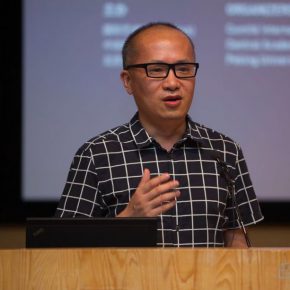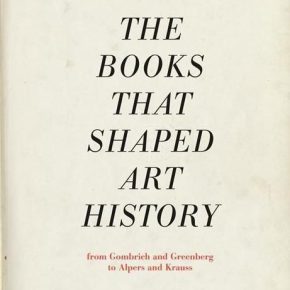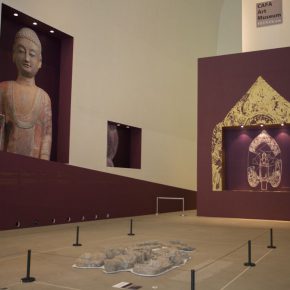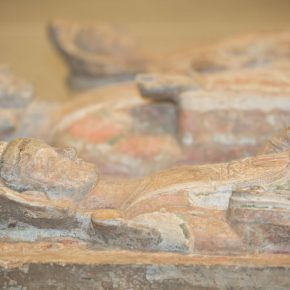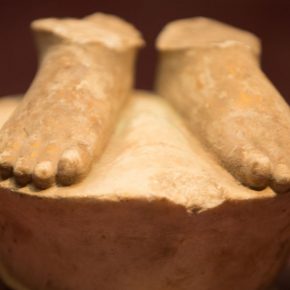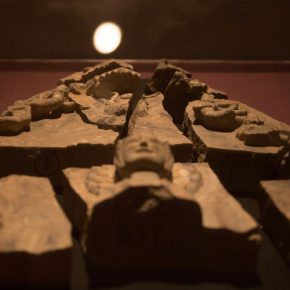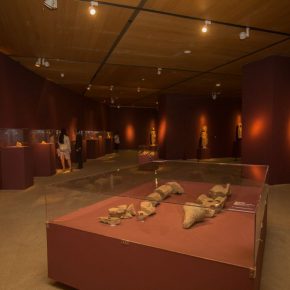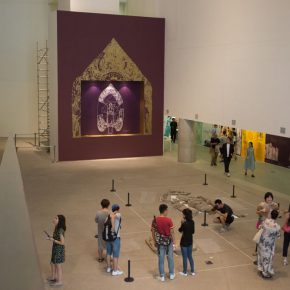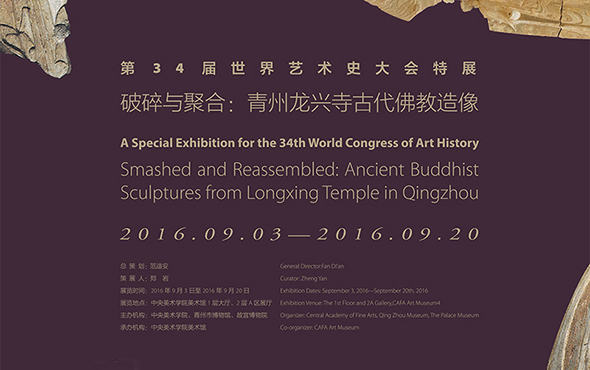
On the afternoon of September 3, 2016, A Special Exhibition for the 34th World Congress on Art History “Smashed and Reassembled: Ancient Buddhist Sculptures from Longxing Temple in Qingzhou” was officially opened to the public at the CAFA Art Museum, it features a total of 50 groups of ancient Buddhist statues. As the curator of the exhibition, Prof. Zheng Yan from CAFA was interviewed by CAFA ART INFO, starting from the planning of the exhibition, to talk about the researching methods on art history, the construction of discipline, as well as the preparatory work of the world congress on art history, etc.
Interview Time: September 5, 2016
Interviewee: Prof. Zheng Yan
Interviewer and Editor: Yu Ya
Translated by Chen Peihua and edited by Sue/CAFA ART INFO
Would you like to briefly explain the reason why you planned the CIHA special exhibition “Smash and Reassembled”? And why do you select to cooperate with Qingzhou Municipal Museum to display these Buddhist statues?Zheng Yan (hereinafter referred to as Zheng): This exhibition is planned in cooperation with the World Congress on Art History. CAFA is the host of this congress and we considered that it was necessary to hold a corresponding exhibition. So I proposed the idea of Qingzhou, an exhibition of Buddhist sculptures. Of course, first of all it is related to the fact that I had worked in Shandong for many years and engaged in the related follow-up work of the excavation of Qingzhou Buddhist sculptures. In addition, when I quietly thought of the planning of the exhibition, there was a problem. What is the impression of “China” that a Western scholar who has never been to China have? I think it is probably a stationary image of ancient China.
These Qingzhou statues were created with a religious background in the beginning, which itself is a cross-cultural phenomenon, and also very easy to penetrate different cultures, so it is also an advantage to present these things. In addition, the exhibition will be on display at the modern CAFA Art Museum, so it is a problem and challenge to break the boundaries of ancient and contemporary.
Observed from the works which are currently on display, it is obvious that in addition to the selected sculptures which are completely preserved, the presentation of fragments also reflects a strong richness. As a curator, what do you think of when you chose works?Zheng: In fact, no matter if it is a boutique or a fragment, it is just the external state of the exhibited work, and considerations on curatorial concepts are critical. It happens to be the 20th anniversary of Longxing Temple’s excavation, and I have done some research on the academic history. You will find that, the related research and exhibitions that we have completed in the past two decades are unfolded in traditional concepts. For example, for the study, we emphasize the study on style, pattern, as well as the study on archaeological typology and chronology. Of course, these studies are the basis for our further discussion, but it also has limitations, namely often being divided into sections. As for the exhibition, many things are from the research and presentations unfolded under the concept of “sculpture” in the modern Western context.
When I am in faced with these statues from Qingzhou, I think of a very simple but fundamental question, Buddhists believed that a Buddha sculpture was the incarnation of Buddha, the incarnation of Sakyamuni. It is actually an idol, and all liturgies are expanded around the Buddha. Buddha is functional. It is both related to the visible object and spiritual object.
Well, why were they broken? Of course, there is a lot of related research and statements, and I think the most convincing one is that they were broken by the repeated demolishing of Buddhism in history. But it is worth noting that more than 95% of these statues appeared in the 6th century, but they were essentially buried 5 hundred years later.
The World Congress of Art History is themed “Terms” (Concept: Art and Art History in Different Histories and Different Cultures), then whether you look forward to borrowing this special exhibition to have a dialogue with the theme of the congress or throw in a question?Zheng: The theme of this congress “Terms” mainly refers to the word or concept, the term that can be discussed and researched. Art is classified into sculpture, painting, architecture, craft art and so on, while these terms were basically formed under a specific Western historical and cultural background, because their writing on art history is powerful. I think the theme of the World Congress actually makes us “rethink” and reflect on this writing on art history.
Reflecting on contemporary art, take Xu Bing’s work “Where Does the Dust Itself Collect?” as an example, 9/11 is a disaster, which resulted in the general waste, the “dust”, but we feel it contains life in Xu’s work, and we even feel that the dust is worth cherishing. In fact, humans have faced many disasters in history, and while the demolishing of Buddhism was one disaster for Buddhists, how will the artists cope with this?
What is the relationship between art history and art creation? In fact, there is not any pure concept of ancient traditional art and many of the concepts were transplanted from the West, but in fact it is short of a genuine Chinese cultural background. So if I start the exhibition from this perspective, I think the ancient and present artistic creation, artists and the problems of art historians can be communicated. Then we can rethink what is the work of art?
In addition to the conventional exhibition shelves, some larger broken statues are directly displayed on the ground and in display cases, which is like “restoring” the state of statues when they were unearthed. Resulting in the presentation style, what do you think?Zheng: Yes, I have also thought of the way of presentation. The way of presentation is associated with the fact that I am engaged in archeology, what is the basic concept of archeology? There is not any concept of boutique, when we participate in excavations. Although there are first-grade and second grade products in the museum, we treat all things equally when we participate in the excavation. No matter gold, silver, pottery or even ancient busts, we equally attach importance to them when dealing with them, and extracting them. Because only in extracting the original habitat, can we see various historical aspects, seeing the entire historical event of the creation, destruction, reassembling and preservation of the Buddha statues.
Therefore, you will think it a modern exhibition of art, which is also my idea. It connects the ancient and contemporary in both the curatorial concept and the external form of presentation, which is really one of my motives.
Putting forward the problem is actually the value of the exhibition.Zheng: Yes, and I think as long as it is a good statue, it can speak by itself. Therefore, so I just want to try to supplement a concept that we see in art history and Chinese art history from the internal Chinese culture and oriental culture. Then we can start from this to discuss how to establish a so-called real “world art history”, which does not use the European system and Western system to write the world art history, but builds the world of art history on the basis of different cultures.
You just mentioned the concept of “world art history”. In fact, CIHA proposed the problem of traditional Western-oriented art history in 1975, pointing out the lack of representatives from Africa and Asia. Since 2004, the Montreal congress and 2008 Melbourne congress, it has been continuously improved. And now it is held in China, what do you think is the main reason for this and is it necessary to change it?Zheng: On the one hand, it is the development of art in the West, it has also been internally reflecting. The writing of old history started from the ancient Egypt to Greece and Rome due to the writing ability and then to the Middle Ages and the Renaissance, until contemporary times which are flawed. On the other hand, it is the development of other regional cultures. So far, the basic grammar, vocabulary, narrative structures of art history are all from the West, and centered on Europe. For example, I bought a book entitled “The Books that Shaped Art History” in the USA., in which we can find that from the late nineteenth century to the present, the books that shaped the basic facial makeup of art history were all written by Western scholars, and they all discussed and studied Western art. It neither contained China, nor Japan, India, South America. So that, while such art history creates achievements, there is still be a huge flaw.
In addition, it also exists in the basic methods of art history. Take Mawangdui as an example, all the things of Mawangdui, including the color of paintings on coffins which were sealed inside, so you can’t see them, how do you research them? In addition, the Dunhuang frescoes are so beautiful, but you need a flashlight to see them if you really go to Dunhuang, or you can’t see the inside frescoes. Then you will think the premise of the research of form in China suddenly disappears. So I think the concept of “world art history” appears because the original art historical system has limitations in a particular cultural background and historical stage, when it faces abundant works of art and art events.
You also talked about the problem of art history discipline in China, what do you think of the current developing situation of art history discipline in China? Whether it is able to achieve an independent power of discourse and an equal communication?Zheng: I think it is still idealistic now, although we have a very proud history, we have “Great Painting Views of Past Dynasties”, and our artistic practices could be traced back to the Neolithic and Paleolithic, art history was as a new modern discipline which started late in China. As a modern discipline, art history was young in China, and the development was not easy. After the reform and opening, the study of art history has rapidly developed in China. In both terms of the research material and researchers, the art history discipline in China is promising. At the same time, the World Congress on Art History will also play a leading role in the study of art history in China in the future.
The final question is this, what do you look forward to from the opening of the World Congress on Art History, and the 7th Session “Translation and Change” which you will host?Zheng: I think it is stated in the key word of the 7th session “Translation”, “Change”. Translation is not a problem of interpretation, but a conversion, namely the communication and conversion between Eastern and Western cultures. This conversion has two aspects, on the one hand the West is transformed to the East, and on the other hand, the eastern concept is transformed to the West. While it is transformed, it brings changes. Overall, it has a future-oriented position and I hope these young scholars are able to play a role.


